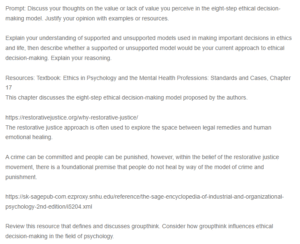The Eight-Step Model
The eight-step ethical decision-making model has its limitations, such as its failure to capture the contextual complexity of dilemmas across various ethical situations and its use of subjective values and interpretations to make ethical choices. However, there is value in the eight-step ethical decision-making model as an ethical decision-making framework.
First, as argued by Banks et al. (2022), a valuable ethical decision-making model is one that is founded on empirical evidence and clear philosophical and practical application of ethical principles. The eight-step ethical decision-making model is valuable in making ethical decisions as it provides a clear, systematic approach and framework to making decisions when faced with an ethical dilemma. The model has clear steps, from gathering facts about the ethical situation and identifying consequences to critically reviewing potential actions and considering your intuition. This systematic approach to decisions makes choosing the course of action possible. One recognizable value of ethical decision-making models is the ability of the models to assist decision-makers in choosing between actions when faced with ethical dilemmas or when choices are unclear (Johnson et al., 2021). The eight-step ethical decision-making model further considers various viewpoints and reflects on each action’s consequences. The structured approach to decision-making in the eight-step ethical decision-making model involves critically considering potential actions and their consequences. This can help overcome the illusions of groupthink and the need to conform to one collectively rationalized action (Taggar, 2017). Therefore, decisions made under the eight-step framework come after critically and creatively considering these possible actions and their consequences. This, therefore, makes it possible to choose the best-fit action to align with the expected outcomes of the decision.
From a personal understanding, supported models are ethical decision-making models that are backed by empirical evidence from extensive research and testing. These models are highly acceptable across various fields by professionals. Additionally, such decision models have a strong theoretical foundation and consider ethical principles in guiding decisions (Johnson et al., 2021). On the other hand, I view unsupported models as decision models that have not been empirically tested and are just based on an individual’s beliefs in relation to a situation. My current approach to ethical decision-making will be based on the supported models. My reasoning is that supported models are based on widely accepted evidence that can help me justify my decisions and selected course of action regardless of the outcomes.
References
Banks, G. C., Knapp, D. J., Lin, L., Sanders, C. S., & Grand, J. A. (2022). Ethical decision making in the 21st century: A useful framework for industrial-organizational psychologists. Industrial and Organizational Psychology, 15(2), 220–235. https://doi.org/10.1017/IOP.2021.143
Johnson, M. K., Weeks, S. N., Peacock, G. G., & Domenech Rodríguez, M. M. (2021). Ethical decision-making models: a taxonomy of models and review of issues. Ethics and Behavior, 32(3), 195–209. https://doi.org/10.1080/10508422.2021.1913593
Taggar, S. (2017). Groupthink. In S. G. Rogelberg (Ed.), The SAGE Encyclopedia of Industrial and Organizational Psychology (2nd ed., Vol. 1, p. 586). SAGE Publications.
ORDER A PLAGIARISM-FREE PAPER HERE
We’ll write everything from scratch
Question 
Prompt: Discuss your thoughts on the value or lack of value you perceive in the eight-step ethical decision-making model. Justify your opinion with examples or resources.

The Eight-Step Model
Explain your understanding of supported and unsupported models used in making important decisions in ethics and life, then describe whether a supported or unsupported model would be your current approach to ethical decision-making. Explain your reasoning.
Resources: Textbook: Ethics in Psychology and the Mental Health Professions: Standards and Cases, Chapter 17
This chapter discusses the eight-step ethical decision-making model proposed by the authors.
The restorative justice approach is often used to explore the space between legal remedies and human emotional healing.
A crime can be committed and people can be punished, however, within the belief of the restorative justice movement, there is a foundational premise that people do not heal by way of the model of crime and punishment.
https://sk-sagepub-com.ezproxy.snhu.edu/reference/the-sage-encyclopedia-of-industrial-and-organizational-psychology-2nd-edition/i5204.xml
Review this resource that defines and discusses groupthink. Consider how groupthink influences ethical decision-making in the field of psychology.